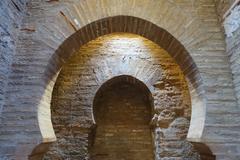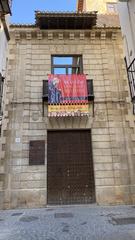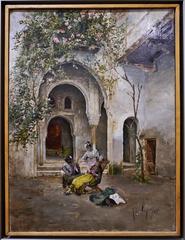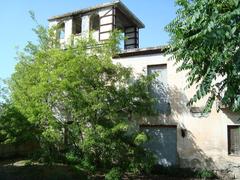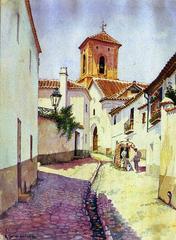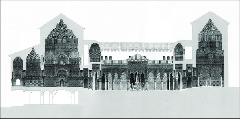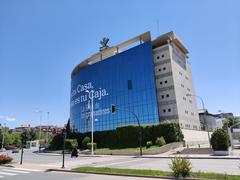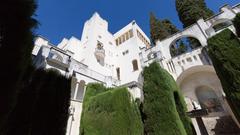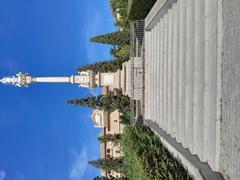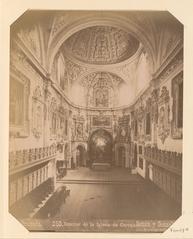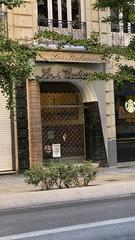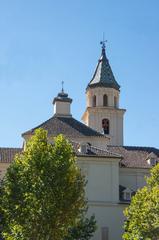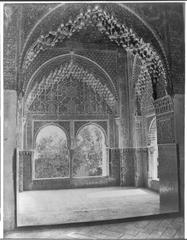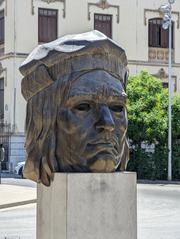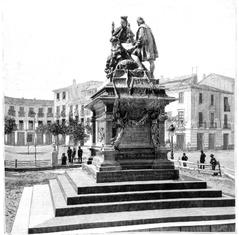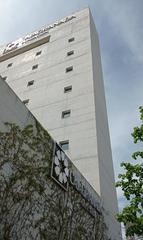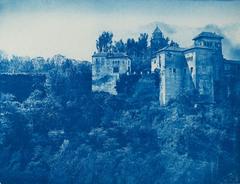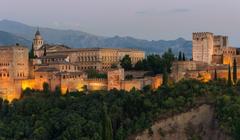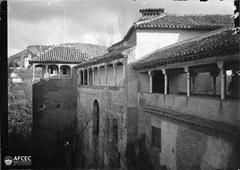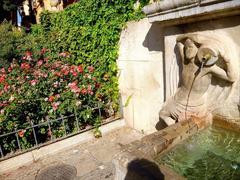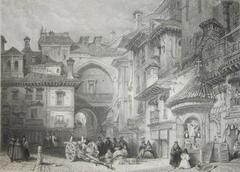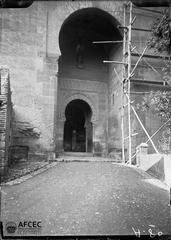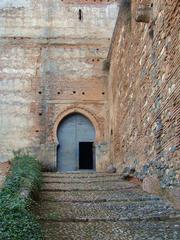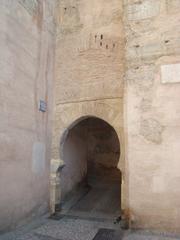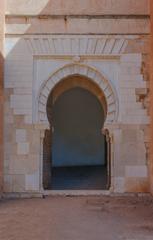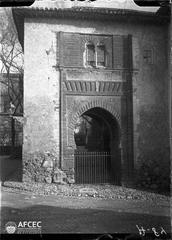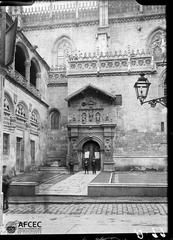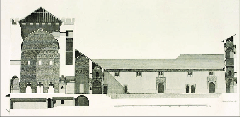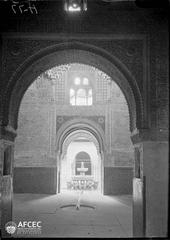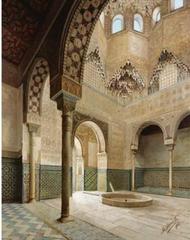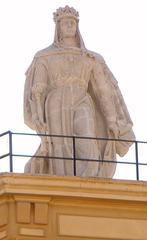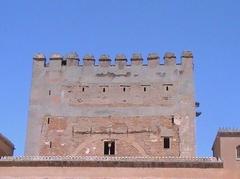Sala de los Mocárabes: Visiting Hours, Tickets, and Granada Historical Sites Guide
Date: 14/06/2025
Introduction to Sala de los Mocárabes and Its Significance in Granada
Within Granada’s renowned Alhambra complex, the Sala de los Mocárabes stands as a symbol of Nasrid ingenuity and the cultural synthesis of medieval al-Andalus. Famous for its intricate muqarnas ceiling—an architectural marvel of interlocking, honeycomb-like forms—the hall embodies the artistic and spiritual ideals of the 14th-century Nasrid dynasty. Once a ceremonial antechamber near the Court of the Lions, the Sala de los Mocárabes is not just a feast for the eyes but a journey into the sophisticated world of Granada before and after the Christian conquest in 1492 (Lumen Learning; YatrikaOne; UNESCO; Alhambra Granada).
This guide provides a detailed overview of the Sala de los Mocárabes’ history, architecture, visiting logistics, accessibility, and travel tips, ensuring you have all the information needed to make the most of your visit to one of Granada’s most treasured historical sites.
Table of Contents
- Introduction
- Nasrid Origins and Early Development
- Architectural Features and Innovations
- Evolution and Function Over Time
- Artistic and Cultural Significance
- Restoration and Preservation
- Visiting the Sala de los Mocárabes: Hours, Tickets, and Tips
- Frequently Asked Questions (FAQ)
- Conclusion
- References
Nasrid Origins and Early Development
The Sala de los Mocárabes is integral to the Nasrid Palaces and reflects the final flowering of Islamic architecture in Iberia. The Nasrid Dynasty established their Granada court in the 13th century, turning the Alhambra into a sophisticated ensemble of palaces and gardens. The Sala was commissioned in the 14th century by Sultan Muhammad V and served as an antechamber for guests entering the Court of the Lions from the west (Lumen Learning; YatrikaOne).
Architectural Features and Innovations
The hallmark of the Sala de los Mocárabes is its muqarnas (mocárabes) ceiling—hundreds of geometric cells arranged in cascading stalactite forms (Alhambra Oculta). This advanced Islamic decorative technique diffuses natural light, creating a luminous, ethereal atmosphere. The design continues throughout arches and walls, with geometric tilework, carved stucco panels, arabesques, and intricate calligraphy symbolizing divine infinity (YatrikaOne; Lumen Learning).
Evolution and Function Over Time
Originally conceived as an antechamber or transitional area, the Sala de los Mocárabes’ exact historical use is debated. It likely served as a waiting area for visitors or as a passage to key palace rooms. After the Christian conquest, the Catholic Monarchs restored and repurposed the space, preserving its architectural essence while adapting it for ceremonial uses and, later, tourism (Academia.edu).
Artistic and Cultural Significance
The Sala epitomizes Granada’s multicultural legacy, blending Islamic, local Andalusian, and even earlier Iberian influences. The muqarnas ceiling is both decorative and deeply symbolic—evoking the heavens and spiritual transcendence. Decorative motifs, Qur’anic inscriptions, and poetic verses reinforce the palace’s role as a “paradise on earth,” merging art and spirituality (Alhambra Granada; UNESCO).
Restoration and Preservation
The Sala de los Mocárabes has endured both neglect and careful restoration, especially after damages in the Peninsular War and a 16th-century explosion that destroyed the original muqarnas ceiling. Recent conservation prioritizes traditional materials and expert craftsmanship to safeguard the delicate stucco and plasterwork (Academia.edu).
Visiting the Sala de los Mocárabes: Hours, Tickets, and Tips
Visiting Hours
The Nasrid Palaces are generally open from 8:30 AM to 6:00 PM (April–mid-October) and 8:30 AM to 4:00 PM (mid-October–March). These hours may vary; always check the official website before visiting.
Tickets and Booking
- Advance Purchase Required: Tickets for the Alhambra (which include the Sala de los Mocárabes) must be bought online well in advance due to high demand (lauradolcitravels.com).
- Timed Entry: Entry to the Nasrid Palaces is strictly timed. Arrive early to allow for walking and security checks.
- Ticket Types: Options include general admission, guided tours, and night visits. Passport or official ID must be shown at entry.
Accessibility
While the Alhambra strives for accessibility, some areas (including the Sala de los Mocárabes) may be challenging due to historic architecture and uneven surfaces. There are ramps and alternative routes where possible; contact the site in advance for support (Alhambra Official Site).
Guided Tours and Special Events
Guided tours (in multiple languages) and audio guides are highly recommended for a richer understanding of the Sala’s history and artistic details. Occasionally, special events or night visits offer a unique perspective on the hall’s ambiance (nomads-travel-guide.com).
Photography and Visitor Experience
- Photography: Non-flash photography is permitted. Tripods and selfie sticks are not allowed (HeyGranada).
- Peak Times: Visit early in the morning or late afternoon to enjoy softer light and smaller crowds.
Nearby Attractions
After the Sala, visit the Court of the Lions, Generalife gardens, Alcazaba fortress, and nearby neighborhoods like Albaicín and Sacromonte for a comprehensive Granada experience (nomads-travel-guide.com).
Practical Tips for Your Visit
- Book tickets at least a month in advance during peak season (lauradolcitravels.com).
- Wear comfortable shoes—the Alhambra requires significant walking on uneven surfaces.
- Bring water and sun protection in summer.
- Allow 2.5–3 hours for the full Alhambra visit, with 45–60 minutes for the Nasrid Palaces and Sala de los Mocárabes.
- Respect conservation rules: No touching walls or decorations.
Frequently Asked Questions (FAQ)
What are the Sala de los Mocárabes visiting hours?
The Nasrid Palaces, including the Sala, are open from 8:30 AM to 6:00 PM in summer and until 4:00 PM in winter, with possible seasonal changes. Check official sources for updates.
How do I buy tickets for the Sala de los Mocárabes?
Tickets must be purchased in advance online through the official Alhambra website or authorized vendors.
Is the Sala de los Mocárabes wheelchair accessible?
Some accessibility accommodations are available, but not all areas are fully accessible due to the historic nature of the site. Contact the Alhambra for specific guidance.
Can I take photographs?
Photography without flash is allowed; do not use tripods or selfie sticks.
What else should I see nearby?
Explore the Generalife, Alcazaba, Albaicín, and Sacromonte districts for a deeper appreciation of Granada’s layered history.
Conclusion
The Sala de los Mocárabes is a highlight of the Alhambra, offering insight into Nasrid artistry, spiritual symbolism, and Granada’s multicultural legacy. With careful planning—securing tickets early, choosing optimal visiting hours, and considering guided tours—visitors can enjoy a memorable, meaningful experience. Don’t miss nearby attractions to fully embrace Granada’s rich past.
Stay informed on opening hours, ticketing, and special events by checking the official Alhambra website and using travel resources. For up-to-date tips, download the Audiala app and explore related content on Granada’s historical sites.
Visuals and Resources
- Official Alhambra Website – Tickets & Visitor Info
- Virtual Tour of the Alhambra
- Alhambra Granada Artistic Introduction
Suggested images:
- Sala de los Mocárabes interior with muqarnas ceiling (alt: “Sala de los Mocárabes interior showcasing Nasrid plasterwork”)
- Alhambra ticket entrance with visitor queue (alt: “Alhambra Granada ticket entrance with visitors”)
- Map of the Alhambra showing Sala de los Mocárabes
References
- Lumen Learning
- Fascinating Spain
- Viva La Vita
- Laura Dolci Travels
- Alhambra Official Site
- Alhambra Granada Artistic Introduction
- Alhambra.info
- UNESCO
- YatrikaOne
- nomads-travel-guide.com
- HeyGranada

